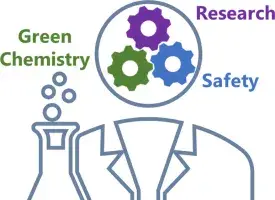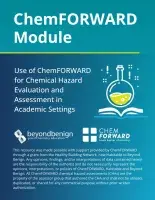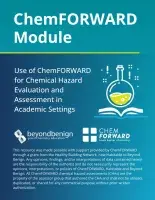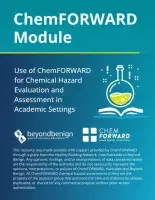Welcome to the GCTLC Library. Use the search and filter options below to find green chemistry education resources and curriculum materials from community members from across the world. You can also submit a new resource to the library. For information for authors and reviewers, please consult the Guidelines for Submission and Review of Learning Objects.

An Innovation Studio Leans into the Power of Green Chemistry
Schoolab is an innovation studio that pairs student teams with corporate partners to solve real-world business & design challenges. In the US, they run a program at the University of California Berkeley called "Deplastify the Planet."
Recently it became clear that the sustainable design solutions they were trying to create would benefit tremendously from taking their design thinking all the ...

Analyzing Sports Drinks with Beer's Law in a Green Chemistry Lab
In this experiment, students use a Go Direct® SpectroVis® Plus Spectrophotometer to determine the concentration of FD&C Blue #1 food dye in various sports drinks through spectrophotometric analysis. By preparing dilutions of the dye and creating a calibration curve, students apply Beer's Law to measure dye concentrations accurately.
The activity emphasizes green chemistry principles by promoting ...

Animal Adaptations & Engineering Design: Lesson 04: Building with Biomimicry
Using biomimicry for ideas, scientists and engineers can create sustainable solutions for a vast range of problems. Scientists consider how plants and animals create a material or perform a process, and engineers then use that information to create inventions that are scalable to meet the needs of people

Antibacterial properties of the halogens
This two-part microbiology practical investigation introduces students to the antibacterial properties of halogen solutions and their use for water treatment from contaminated sources.

Approaches to Incorporating Green Chemistry and Safety into Laboratory Culture
This is an open access article linked from the Journal of Chemical Education article. It highlights a systems thinking approach to incorporating green chemistry and safety into laboratory culture. This article, emphasizes how framing green chemistry through the lens of systems thinking can build a culture of safety in the laboratory.

Aqueous-Phase Palladium-Catalyzed Coupling. A Green Chemistry Laboratory Experiment
This experiment highlights both the importance of palladium-catalyzed coupling reactions and the need for finding greener solvents. The aqueous-phase coupling of iodobenzene and diethylphosphite is a great example of how a reaction can be made greener with a relatively straightforward modification. By simply sulfonating triphenylphosphine, students will be synthesizing a water-solubilizing ligand ...

Assessment of Student Knowledge of Green Chemistry Principles
The following abstract is excerpted from the linked external resource.
"As implementation of green chemistry into university-level courses increases, it is vital that educators have a tool to rapidly measure student knowledge of green chemistry principles. We report the development of the Assessment of Student Knowledge of Green Chemistry Principles (ASK-GCP) and evaluation of its sensitivity ...

Bees, Bananas, Benign - Green Chemistry Poster
Poster promoting green chemistry.
Isoamyl acetate is used in many products, adding banana flavor to food, providing a sweet smell, or serving as an ingredient in varnishes. The trouble is that isoamyl acetate is synthesized through the Fischer esterification reaction, which requires the use of sulfuric acid as a catalyst and ether to extract the chemical. Using the principles of green chemistry ...

Beyond Benign Greener Solvent Guide
The greener solvent guide by Beyond Benign was created based on existing solvent selection guides available in the literature (referenced in the attached PDF). It was meant to help synthesize the information in existing guides into a simple graphic that can be quickly referenced and placed in the workplace for ease-of-use and access. The guide is often printed as a magnet and placed in ...

Biochemistry
This module is part of a collection of nine green chemistry teaching modules developed in the early 2000s by a team of faculty (Donna Narsavage-Heald, Trudy Dickneider, David Marx, Timothy Foley, Joan Wasilewski) led by Michael Cann at the University of Scranton and has been migrated to the GCTLC. The subjects of the modules are based on winners of the Green Chemistry Challenge Awards. The modules ...

Biomimicry Matching Game
Biomimicry is the science and art of emulating nature’s best biological ideas to solve human problems. The natural world is made up of very good green chemists. Consider animals and how they make their own shelter and get all the food they need from other things in nature. This is all done without having to use any gas or electricity or taking more than they need, and they produce little waste or ...

Bringing State-of-the-Art, Applied, Novel, Green Chemistry to the Classroom by Employing the Presidential Green Chemistry Challenge Awards
In 1995 President Clinton introduced the Presidential Green Chemistry Challenge (PGCC) Awards Program. The program was created to acknowledge companies and individuals who research and develop technologies "that promote pollution prevention and industrial ecology through a new EPA Design for the Environment partnership with the chemical industry." In this article, Dr. Michael Cann discusses two ...

Calorimetry
Three “coffee-cup” calorimetry experiments:
1) Use of the Law of Dulong and Petit to identify an unknown metal
2) Measurement of the enthalpy of sublimation of dry ice
3) Exploration of the relationship between surface area and the rate of heat transfer and the amount of heat transferred
Featuring contributions from Tamara Fitzjarrald

Can Biodegradable Materials Replace Plastic as Protective Food Packaging?
Many foods, such as fresh fruits, vegetables, or eggs, are packaged in plastic to protect them from damage during handling and transport. But is plastic the best choice? What if a more sustainable and biodegradable material could replace it? Researchers have begun exploring hydrogels—squishy materials that can hold a lot of water—as alternative packaging materials. In this science project, you ...

Careers Highlighting Green Chemistry and Sustainable Design in Chemical or Product Manufacturing Companies
This resource provides a list of videos and written stories that can be used in career exploration with students in secondary and higher education. Resources highlight careers that make use of green chemistry and sustainable design principles.

Careers in Green Chemistry and Sustainable Design: Video Series for Secondary Classrooms and Activity Guide
The Careers in Green Chemistry and Sustainable Design video series highlights professionals in Washington whose careers impact products or chemicals used in Washington. Each of these videos highlights a career that connects to green chemistry and sustainable design. In each video, the professionals share their reflections in response to a series of interview questions. The videos are five to ten ...

Case study assessment using biobased 5-hydroxymethylfurfural to teach redox reactions in undergraduate organic courses
Abstract: This paper addresses the development and evaluation of a case study designed to introduce both the core chemistry concepts of oxidation and reduction reactions as well as green chemistry within the undergraduate organic chemistry curriculum. The developed case study consisted of two parts that can be used in tandem or independently. Part 1 focused on calculating oxidation states and ...

Catalyzing the Development of Self-Efficacy and Science Identity: A Green Organic Chemistry CURE
To remain globally competitive, education in the United States must focus on retaining students in science, technology, engineering, and mathematics (STEM). As laboratory courses have the potential to be powerful attractors or deterrents to a field, developing effective laboratory pedagogies is important to retain students in STEM. A course-based undergraduate research experience (CURE) is one ...

CHEM21 selection guide of classical- and less classical-solvents
This article provides a ranking of and selection guide for both classical and less classical solvents, based on existing solvent selection guides as well as a set of proposed criteria on Health, Safety and Environment aligned with the Global Harmonized System (GHS) and European regulations. More details are available in the linked article.
Full citation: Prat, D.; Wells, A.; Hayler, J.; Sneddon ...

ChemFORWARD Module Overview
The ChemFORWARD module aims to help instructors teach students how to use the ChemFORWARD platform to obtain hazard information for specific chemicals, and to identify safer chemicals to replace chemicals of concern in research and in product formulations.
The module is organized into two units. Each unit contains a unit overview, specific learning outcomes, course alignment, prerequisites ...

ChemFORWARD Module Unit 0: Background materials
These materials provide a brief overview of hazard, risk, personal protective equipment, chemical hazard assessment, chemical risk assessment, and chemical alternatives assessment for use in introductory courses where students have not previously been exposed to these topics. These materials are not meant to provide exhaustive coverage of the topics, but a general overview for an introductory ...

ChemFORWARD Module Unit 1: Introduction to ChemFORWARD, and Use of ChemFORWARD to Find Safer Chemical Alternatives
This unit provides details on the organization and use of the ChemFORWARD platform, the information that can be obtained using the platform, and how to use the platform to find safer chemical alternatives for chemicals of concern. Details are provided in the ChemFORWARD How-To Guide. Pertinent slides with screenshots are provided. Students can be directed to the diethyl phthalate example ...

ChemFORWARD Module Unit 2: Avoiding Regrettable Substitutions, Natural Is Not Always Safer
This unit reiterates the importance of avoiding regrettable substitutions, emphasizes the importance of data gaps, and also cautions that naturally-occurring chemicals are not always safer, regardless of the many claims made in some consumer products.
This module unit was reviewed by Julian Silverman (Ph.D.) and Sarah Prescott (Ph.D.).
The inspiration of this work began with a Forsythia ...

Chemical Hazard Awareness Module
The Chemical Hazard Awareness Module is designed to be used in conjunction with a laboratory exercise that you currently use in your classroom or laboratory. We have outlined this exercise for use with Beyond Benign’s laboratory exercise “Reactions Lab” (found online here: http://www.beyondbenign.org/K12education/highschool.html). The Reactions Lab allows students to observe different types of ...

Chemical or Physical Change?
This lab replaces traditional reactions involving chemicals such as cupric chloride (copper (II) chloride), 6 M hydrochloric acid, potassium hydroxide, and copper (II) sulfate. Students will understand the difference between chemical and physical changes while using all greener materials.
This lab is designed for when for students have minimal lab experience. The goal is to use observations of ...

Chemists' role in the fight against disease
Chemists design, create and modify molecules to produce new and useful materials such as pharmaceuticals. Research and development of new medicines and vaccines against communicable and non-communicable diseases is vital in helping to achieve the UN’s sustainable development Goal 3: ensure healthy lives and promote well-being for all at all ages.

Chiral Compounds and Green Chemistry in Undergraduate Organic Laboratories: Reduction of a Ketone by Sodium Borohydride and Baker's Yeast
Chiral compounds can have unique properties and are becoming increasingly important in pharmaceutical, chemical, and agricultural industries. In this laboratory exercise, students compare and contrast chemical vs. enzyme-mediated procedures for introducing chirality into a molecule and gain experience with the principles and experimental techniques used to prepare and separate enantiomers. Over ...

Chlorinated Solvents: Their Advantages, Disadvantages, and Alternatives in Organic and Medicinal Chemistry
This published article provides a comprehensive overview of chlorinated solvents in medicinal and organic chemistry, including the numerous properties that have made them a historically popular choice, their significant disadvantages and health and safety considerations, and recommendations for choosing viable alternatives for numerous common reactions and laboratory applications.

Cinnamon Oil: An Alternate and Inexpensive Resource for Green Chemistry Experiments in Organic Chemistry Laboratory
We report a series of experiments based upon cinnamon oil that were developed to provide a practical integration of green and sustainable chemistry concepts for the organic chemistry laboratory. Five experiments centering around cinnamaldehyde as a green, plant-based chemical were performed by undergraduate students in a second-year organic chemistry class. Cinnamon oil was obtained through ...

Climate Change Chemistry
This curriculum unit is focused on exploring the scientific concepts of climate change, specifically within the field of chemistry. The unit aims to provide students with a foundational understanding of the chemistry involved in climate change models, predictions, and policy. The focus is on removing political connotations associated with the term “greenhouse gases” and restoring its scientific ...

Cocrystal Controlled Solid-State Synthesis. A Green Chemistry Experiment for Undergraduate Organic Chemistry
In this set of experiments, students will be introduced to condensation reactions, green chemistry, and cocrystal-controlled solid-state synthesis. This type of solid-state synthesis is performed by first making cocrystals of the two reactants (in this case an anhydride and an amine) which brings the reactive functional groups in close proximity to one another, allowing for a reaction to occur ...

Comparative Methylation of 1,8-Dihydroxy-9,10-anthraquinone: Chemoselectivity in the Organic Chemistry Laboratory
This experiment demonstrates chemoselectivity in various reaction conditions. The mono or di-methylation of 1,8-dihydroxy-9,10-anthraquinone can be controlled by either refluxing the reagents in tetraglyme or by simply heating without solvent. Also, this ether synthesis has been made greener by eliminating flammable THF and dangerous sodium hydride and by using a less toxic methylating agent. ...

Comparing Industrial Amination Reactions in a Combined Class and Laboratory Green Chemistry Assignment
In this published article (J. Chem. Educ., 2019, 96, 1, 93-99), we describe a green chemistry combined in-class and laboratory module for upper-year organic chemistry students. Through completing this combined module, students will compare and contrast the greenness of two industrially-relevant amination reactions to create the same target molecule. One of these amination reactions will be ...

Cooperative Organic Chemistry Laboratory
This laboratory curriculum uses project-based learning to engage second-year organic chemistry students in investigations which incorporate green chemistry decision-making. The basis for this laboratory curriculum is to experience science from the perspective of an organic chemist. Working in groups, students are tasked with a project requiring them to design and carry out an investigation ...

Designing 3 experiments from Vinegar and an Antacid
In this activity, students explore how much Carbon Dioxide is produced from varying combinations of reactants. Students use stoichiometric calculations to determine the theoretical anticipated amount of CO2. Students record observations and measurements of mass of reactants before and after the reaction. Students use the recorded measurements to calculate the amount of Carbon Dioxide produced.In ...

Determination of the Formula of a Hydrate: A Greener Alternative
The determination of the formula of a hydrate is an experiment that introduces students to many fundamental chemical concepts including stoichiometry, the notion of a mole, and nomenclature. In this experiment, the authors replaced the previously used calcium and barium salts because the latter is considered poisonous and tumorigenic, and both were considered waste after only one use. Instead ...

Determination of the Heat of Combustion of Biodiesel Using Bomb Calorimetry. A Multidisciplinary Undergraduate Chemistry Experiment
This lab teaches important basic chemistry skills in the context of utilizing renewable feedstocks. In a three-week series of experiments, students will synthesize biodiesel from peanut oil and determine the heat of combustion, density, and cloud point of their product. Students will then use this information to evaluate the viability of biodiesel when compared to petroleum diesel.
Physical ...

Developing and Disseminating NOP: An Online, Open-Access, Organic Chemistry Teaching Resource To Integrate Sustainability Concepts in the Laboratory
In order to instill an increased awareness of sustainability issues in future generations of scientists, the concepts and content of science courses must be changed. While important chemical concepts must be preserved, outdated, dangerous, and wasteful chemistry should be replaced by current, more sustainable alternatives. With these beliefs in mind, six German universities combined forces and ...

Dissolved Substances in Tap Water and Seawater
The experiment "Dissolved Substances in Tap Water and Seawater" involves students evaporating tap water, distilled water, and seawater to observe solid residues. They also witness an instructor-led demonstration where gases are released from boiling these waters, collected, and tested. This practical activity helps illustrate the different dissolved substances in various water types, showcasing ...

Dye-Sensitized Solar Cell
There is a growing need to investigate alternative energy resources due to the depletion of petroleum, a widely used energy source. Solar energy, or energy from the sun, is a free, readily available, plentiful resource that can be collected by solar cells to generate electricity.
Although solar cells have been around for a long time, their use for energy generation is not widespread. This is ...

Dyeing to Degrade: A Bioplastics Experiment for the College and High School Classroom
The experiment was published in the Journal of Chemical Education @ https://pubs.acs.org/doi/abs/10.1021/acs.jchemed.9b00461 by co-authors Knutson, C. M.; Hilker, A.; Tolstyka, Z. P.; Wilbon, P. A.; Mathers, R. T.; Anderson, C. B.; Perkins, A. L.; Wissinger, J. E.

E-factor
E-factor is a metric that measures the overall efficiency in terms of waste generation of a chemical reaction. E-factor stands for the "Environmental Impact Factor" and is the ratio of how much waste is produced per unit of product made:
E factor= (mass of waste produced (g))/(mass of isolated product (g))
As a result, the lower the E-factor, the more sustainable and less wasteful the reaction ...

E10 petrol and climate change | 14–16 years
This resource includes teacher notes and a student worksheet about E10 petrol, which became the standard 95-octane fuel in Great Britain in 2021 and Northern Ireland in 2022. Students read an extract from a news article and answer related questions. Sue Ali, from the Royal Society of Chemistry, is the author of this resource.

Effects of a CURE Laboratory Module on General Chemistry Students’ Perceptions of Scientific Research, Green Chemistry, and Self-Efficacy
This study describes the effects of implementing a Course-Based Research Experience (CURE) module involving materials science research with a green chemistry synthetic method on student's scientific research, green chemistry, and research skills self-efficacy. The CURE was implemented in a second-semester general chemistry laboratory course.
Effects of a CURE Laboratory Module on General ...

Empirical Formula
Traditional labs used to teach the concept of empirical formula, such as the synthesis of magnesium oxide, reactions between sulfur and copper or iron, or the decomposition of silver oxide, require high energy and may result in the production of dangerous compounds. This alternative method uses greener reactants and produces rust at ambient temperatures. Student results may vary depending on the ...

Enantioselective Reduction by Crude Plant Parts: Reduction of Benzofuran-2-yl Methyl Ketone with Carrot (Daucus carota) Bits
Biocatalysis and biotransformations are important alternatives to consider when one is looking to substitute a conventional method with a greener one. One of the many advantages of using biotransformation as a synthetic method is that they are usually done in water and at ambient conditions. In addition, the reagents themselves are readily available, safe, and inexpensive to both buy and dispose ...

Environmental Activities for the Classroom: Product Life-Cycle Analysis
Consumption of products drives an array of extraction, manufacturing, processing, transportation, and disposal operations. An analysis of these operations, called life-cycle or cradle-to-grave analysis, documents the inputs (water, energy, raw materials) and outputs (products and wastes), for these various steps. The objective of this lesson is to have students become aware that the products they ...

Environmental Chemistry
This module is part of a collection of nine green chemistry teaching modules developed in the early 2000s by a team of faculty (Donna Narsavage-Heald, Trudy Dickneider, David Marx, Timothy Foley, Joan Wasilewski) led by Michael Cann at the University of Scranton and has been migrated to the GCTLC. The subjects of the modules are based on winners of the Green Chemistry Challenge Awards. The modules ...